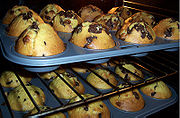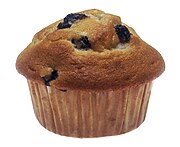
Muffins
A muffin is a type of bread that is baked in small portions. Many forms are somewhat like small cakes or cupcakes in shape, although they usually are not as sweet as cupcakes and generally lack frosting. Savory varieties, such as cornbread muffins, also exist. They generally fit in the palm of an adult hand, and are intended to be consumed by an individual in a single sitting.
Muffin can also refer to a different baked good: the smaller, disk-shaped English muffin, although this usage is uncommon outside of the Commonwealth of Nations. As American-style muffins are also sold in Commonwealth countries, the term muffin can refer to either product, with the context usually making clear which is meant.
There are many varieties and flavors of muffins made with a specific ingredient such as blueberries, chocolate chips, cucumbers, raspberry, cinnamon, pumpkin, date nut, lemon, banana, orange, peach, strawberry, boysenberry, almond, and carrot. These ingredients are then baked into the muffin. Muffins are often eaten for breakfast; alternatively, they may be served for tea or at other meals.
Modern history

Muffins baking in an oven
A somewhat odd combination of circumstances in the 1970s and 1980s led to significant changes in what had been a rather simple, if not prosaic, food. The decline in home-baking, the health food movement, the rise of the specialty food shop, and the gourmet coffee trend all contributed to the creation of a new standard of muffin.
Preservatives in muffin mixes led to the expectation that muffins did not have to go stale within hours of baking, but the resulting muffins were not a taste improvement over homemade. On the other hand, the baked muffin, even if from a mix, seemed almost healthy compared to the fat-laden alternatives of doughnuts and Danish pastry. "Healthful" muffin recipes using whole grains and such "natural" things as yogurt and various vegetables evolved rapidly. But for "healthful" muffins to have any shelf-life without artificial preservatives, the sugar and fat content needed to be increased, to the point where the "muffins" are almost indistinguishable from cupcakes. The rising market for gourmet snacks to accompany gourmet coffees resulted in fancier concoctions in greater bulk than the original, modestly sized corn muffin.The marketing trend toward larger portion sizes also resulted in new muffin pan types for home-baking, not only for increased size. Since the area ratio of muffin top to muffin bottom changed considerably when the traditional small round exploded into a giant mushroom, consumers became more aware of the difference between the soft texture of tops, allowed to rise unfettered, and rougher, tougher bottoms restricted by the pans. There was a brief foray into pans that could produce "all-top" muffins, i.e., extremely shallow, large-diameter cups. Along with the increasing size of muffins is a contrary trend of extremely small muffins. It is now very common to see muffin pans or premade muffins that are only one or two inches in diameter.
Types of muffins
English Muffin

A split English muffin
The English muffin is very different from the variety described on this page. The "English muffin" is yeast leavened and predates the baking powder leavened muffins. This produces a type of muffin with a thick, fluffy pastry and is usually baked as a disk typically about 8 cm in diameter. It is usually split into two, toasted and buttered, and bears a vague resemblance to a crumpet or pikelet. It also is eaten cold with a hot drink at coffee shops and diners. In her Boston Cooking-School Cook Book, Fannie Farmer gave recipes for both types of muffins, distinguishing between "raised" and adding instructions for a version that is nearly identical to today's "English muffin." Here the raised-muffin mixture was cooked in muffin rings on a griddle and flipped to brown both sides, producing a grilled muffin. Farmer indicated this was a useful method when baking in an oven was not practical.
Corn Muffin
Muffins made from cornmeal are popular in the United States. Though corn muffins can simply be muffin shaped cornbread, corn muffins tend to be sweeter. Similar to the pan variety, corn muffins can be eaten with butter or as a side dish with stews or chili.
Muffin paper cups

A blueberry muffin in a paper muffin cup.
Muffin paper cups are round sheets of paper, foil or metal,[1] with scallop-pressed edges, giving the muffin a round cup shape. Their shape can be compared to that of a disposable coffee filter. Muffin paper cups are used to line the bottoms of muffin pans, used in the baking of muffins to facilitate the easy removal of the finished pastry from the muffin tin.
The advantage to cooks is easier removal and cleanup, more precise form, and moister muffins; however, using them will prevent a crust.[2]
References
[1] "Hormel Foods". http://www.hormel.com/kitchen/glossary.asp?id=35798. Retrieved on 2007-04-19.
[2] "The Joy of Baking". http://www.joyofbaking.com/muffins/muffins.html. Retrieved on 2007-04-11.


























No comments:
Post a Comment